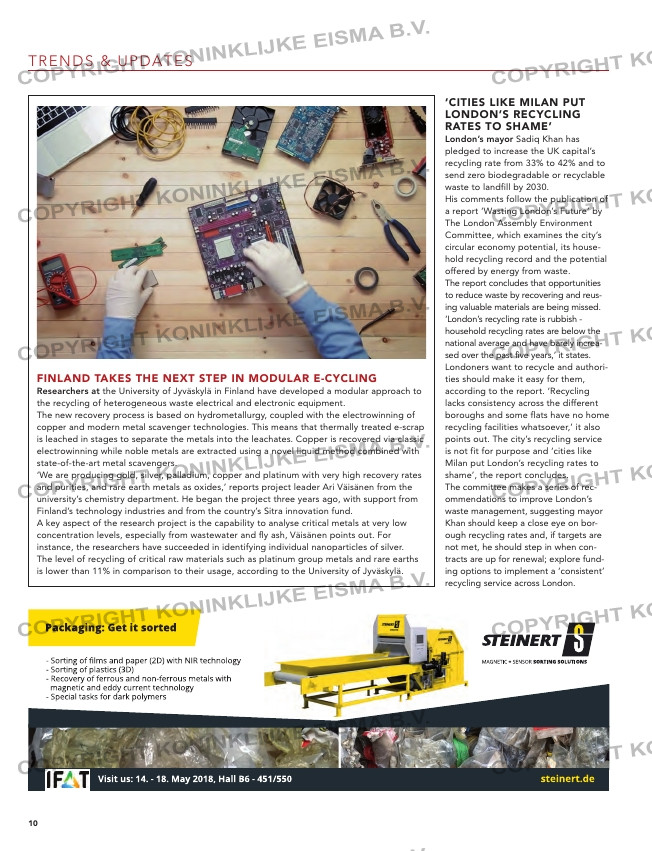Page 10 from: May / June 2018

10
TRENDS & UPDATES
anz_recyclinginternational_magazin_205x64_unisort_pr_IFAT_EN.indd 1 19.04.18 09:07
‘citieS like milaN put
loNdoN’S recycliNg
rateS to Shame’
London’s mayor Sadiq Khan has
pledged to increase the UK capital’s
recycling rate from 33% to 42% and to
send zero biodegradable or recyclable
waste to landfill by 2030.
His comments follow the publication of
a report ‘Wasting London’s Future’ by
The London Assembly Environment
Committee, which examines the city’s
circular economy potential, its house-
hold recycling record and the potential
offered by energy from waste.
The report concludes that opportunities
to reduce waste by recovering and reus-
ing valuable materials are being missed.
‘London’s recycling rate is rubbish –
household recycling rates are below the
national average and have barely increa-
sed over the past five years,’ it states.
Londoners want to recycle and authori-
ties should make it easy for them,
according to the report. ‘Recycling
lacks consistency across the different
boroughs and some flats have no home
recycling facilities whatsoever,’ it also
points out. The city’s recycling service
is not fit for purpose and ‘cities like
Milan put London’s recycling rates to
shame’, the report concludes.
The committee makes a series of rec-
ommendations to improve London’s
waste management, suggesting mayor
Khan should keep a close eye on bor-
ough recycling rates and, if targets are
not met, he should step in when con-
tracts are up for renewal; explore fund-
ing options to implement a ‘consistent’
recycling service across London.
fiNlaNd takeS the Next Step iN modular e-cycliNg
Researchers at the University of Jyväskylä in Finland have developed a modular approach to
the recycling of heterogeneous waste electrical and electronic equipment.
The new recovery process is based on hydrometallurgy, coupled with the electrowinning of
copper and modern metal scavenger technologies. This means that thermally treated e-scrap
is leached in stages to separate the metals into the leachates. Copper is recovered via classic
electrowinning while noble metals are extracted using a novel liquid method combined with
state-of-the-art metal scavengers.
‘We are producing gold, silver, palladium, copper and platinum with very high recovery rates
and purities, and rare earth metals as oxides,’ reports project leader Ari Väisänen from the
university’s chemistry department. He began the project three years ago, with support from
Finland’s technology industries and from the country’s Sitra innovation fund.
A key aspect of the research project is the capability to analyse critical metals at very low
concentration levels, especially from wastewater and fly ash, Väisänen points out. For
instance, the researchers have succeeded in identifying individual nanoparticles of silver.
The level of recycling of critical raw materials such as platinum group metals and rare earths
is lower than 11% in comparison to their usage, according to the University of Jyväskylä.
06-07-09-10-12-13-14_trendsupdates18ad.indd 10 24-04-18 16:30



